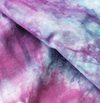In the cross-stitch community, like in many hobbyist circles, there are several slang terms and abbreviations that are commonly used. These terms help stitchers communicate more efficiently about their projects and techniques. Here are some of the most common slang terms and abbreviations you might encounter:
1. WIP: "Work In Progress." This refers to any cross-stitch project that a stitcher has started but hasn't finished yet.
- Monogamous stitchers have only one WIP at any one time
- Most of the rest have anywhere from 2 to over 100 WIPs going. On FlossTube you'll see channels every year doing at least one "WIP Parade." This is when they will go through all of the patterns that they have at least started (only one stitch is needed for it to be considered a WIP).
2. UFO: "Unfinished Object." Similar to WIP, but often implies a project that has been set aside for a long time and may or may not be completed.
3. FO: "Finished Object." A project that is completely finished, including any final touches like washing, ironing, and framing.
- Stitchers will sometimes hedge with the term "FO" and use "FFO" instead to signify that a project is done and has been framed (FFO can mean Fully Finished Object or Finally Framed Object)
- I actually prefer differentiating FO vs FFO as I have several FO's in my collection that just need to be ironed and framed. They've been stitched for a while.
4. SAL: "Stitch-A-Long." This is a group project where multiple stitchers work on the same pattern or theme simultaneously, often sharing progress online.
- These are incredibly popular in the cross-stitch community. Many times a new portion of the patter is released a month at a time. Mystery SALs are those in which the stitcher doesn't know what the end product is going to look like!
- Stores will even carry materials for the SALs which makes it easier for new stitchers to join in any time of the year
- As of right now, there are no SALs in the Stitching Jules Design catalog
5. Frogging: This term comes from the phrase "rip it, rip it," which sounds like a frog's croak. It means to undo or remove stitches due to a mistake.
- If you haven't had to frog a significant portion of any beloved project, then you must be brand new to the hobby.
- I highly recommend not "ripping" out your stitches. Be gentle. You'll need to stitch in this same area with more stitching later.
6. Ort: Old remnants of thread. These are the small pieces of thread left over after you’ve cut your thread and finished stitching with it. Some stitchers collect ors in jars or bags. One of my fellow stitchers actually gave me a Christmas ornament filled with the Orts of a project she had stitched for me. So cool!
7. Biscornu: A type of small, eight-sided, decorative pincushion commonly seen in cross-stitching.
8. Floss: Another term for embroidery thread. The most common floss used in cross-stitch is stranded cotton floss.
9. HAED: "Heaven and Earth Designs." This refers to a brand known for its intricate and detailed cross-stitch patterns, often a term used to describe any large, complex project.
10. Railroading: A technique used to make stitches lay flat and neat by separating the strands of the thread as the needle passes through the fabric.
11. DMC: A reference to a popular brand of thread used in cross-stitch. Often, patterns will list the DMC color numbers needed for the project.
12. Count: Refers to the number of stitches per inch possible on a given fabric. Common counts include 14-count, 16-count, 18-count, etc.
13. LNS: "Local Needlework Shop." A store specializing in needlework supplies that is close enough to you that you visit physically in person.
14. Conversion: Changing the colors or threads recommended in a pattern to ones the stitcher prefers or has available.
15. Stash: Refers to a stitcher's collection of materials like threads, fabrics, patterns, and tools.
Understanding these terms can be helpful for anyone new to cross-stitch, as they are often used in patterns, tutorials, forums, and social media groups related to the craft.







